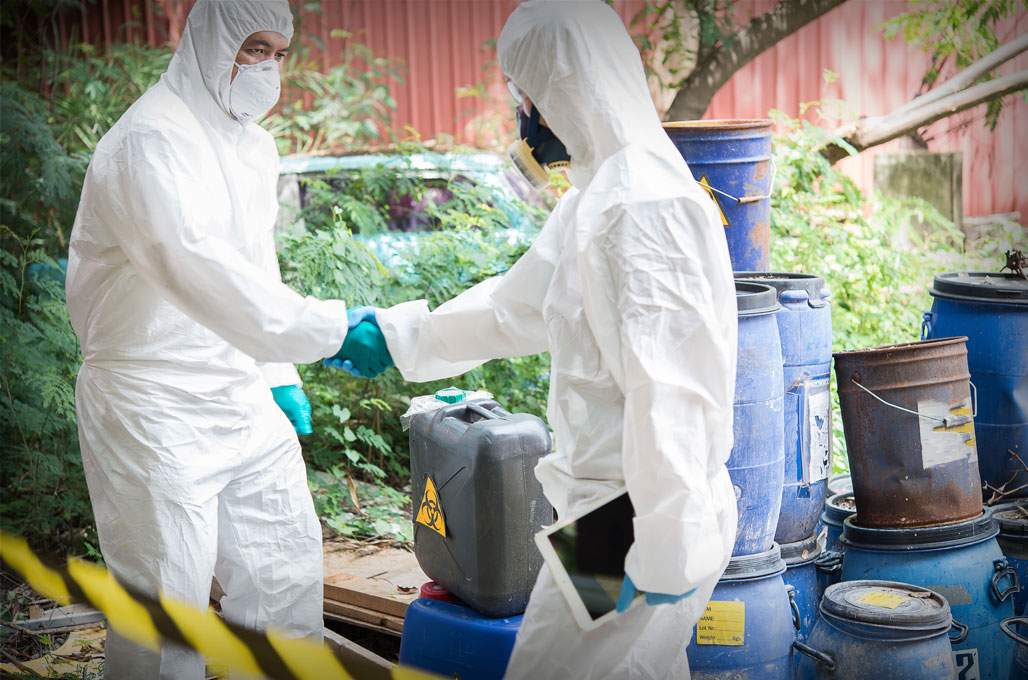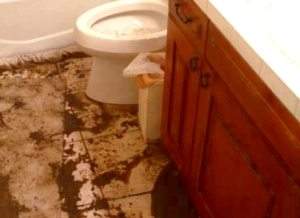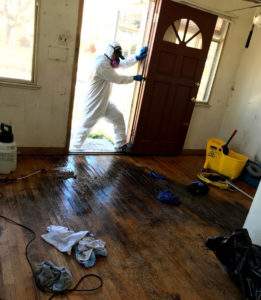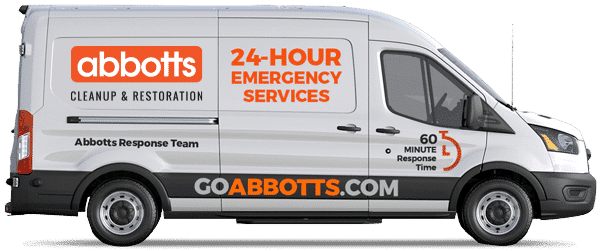ABBOTTS BLOG
What to Do After Your Sewage Backs Up

A backed-up sewer is something every homeowner dreads. Beyond the disgusting odor and mess, raw sewage overflow is incredibly hazardous to your health, and proper cleanup is necessary in order to ensure contaminants don’t remain in your home and on your belongings, just waiting to get members of your household sick. For more information on the danger of contaminants watch our informational video.
What is Sewage?
Referred to as raw sewage, sewage sludge, or a septic tank backup, the sewage that backs up into your home is a mixture of water, human waste, garbage, and mineral salts. Sewage backs up when there is a problem in the plumbing system designed to drain waste away from your home.
Causes of Sewage Backup
 There are a variety of root causes of a raw sewage backup. The blockage may be in the private or main sewer. If it is located in your private sewer, you are responsible for handling it, whereas if it is located beyond your property, the burden may be on the city.
There are a variety of root causes of a raw sewage backup. The blockage may be in the private or main sewer. If it is located in your private sewer, you are responsible for handling it, whereas if it is located beyond your property, the burden may be on the city.
The three most common causes of sewage backups are:
- Clogged pipes — The pipes may either be clogged within your home or beyond it. If you have not yet experienced a sewage backup, and are dealing with a problem with only one fixture, you can fix that by isolating and dealing with that individual clog. However, if flushing a toilet causes water to rise in other water fixtures, you’re dealing with a bigger problem and likely will experience sewage overflow if the problem is not addressed.
- Tree roots — You may be surprised to discover that tree roots are one of the main contributors to sewer line problems. The roots seek out the water inside of the pipes, and can pierce holes through them or wrap around the sewer line, crushing it. If the trees are on your property, then this is likely a problem you will have to solve, whereas if the trees are on city property, it is a public issue.
- Damaged sewer lines — Older properties have pipes and sewers made of cast iron and/or clay, which can break down after years of wear. If you are in an older home or housing development, cracked or broken sewer lines may be an issue.
If you are familiar with your home’s plumbing, you can take some steps to see whether the blockage is within your home or beyond it. If you can’t figure it out, you’ll want to bring in a plumber, or contact your local municipality if you believe the blockage is beyond your property lines.
You will want to check for standing water in the cleanout of your sewer drain to see whether the backup is located before or beyond that point. The sewer drain cleanout is normally located on the lateral line between the home and the sewer main, one to two feet away from the house. Remove the cap and check for standing water in the sewer drain cleanout. If there is water, the backup is located beyond that point, and will likely need to be handled by the city. If that is the case, contact them immediately, as they will need to repair it in order for your backed up water to drain.
If there is no water in the cleanout, the backup in between that point and your house, so you will need to locate and fix it. Check all of your toilets, sinks, and wastewater pipes to try to locate the blockage. If you cannot locate and fix the blockage on your own, bring in a plumber to do so.
You cannot truly begin the process of cleaning up the sewage backup until its cause has been determined, and the water drained.
Health Hazards
Raw sewage contains a number of microorganisms that are hazardous to your health, including coliform, fecal coliform, Escherichia coliform and Enterococcus. Unprotected contact with these bacteria and viruses can cause health problems including E. coli poisoning and Hepatitis.
The noxious fumes from sewage can even contaminate the air, leading to gastroenteritis and occupational asthma simply from breathing in the contaminants.
It is extremely important to protect yourself from these toxins. The most common way to become sick from raw sewage is via hand-to-mouth contact, which is hard to avoid if you are not wearing rubber gloves and a mask while interacting with your surroundings.
Inhalation and consumption of these bacteria can also lead to illness. If any food, water, or eating utensils have been contaminated, they should be disposed of (or cleaned and sterilized, in the case of utensils).
Direct contact with skin can also lead to irritation, and should be avoided.
It is recommended that anyone handling raw sewage overflow wear rubber gloves, rubber boots, and a mask, at the very least. If you believe sewage has reached any part of your HVAC system, contact a professional sewage remediation company to figure out next steps.
Other Safety Concerns
As always, practice fire and electrical hazard safety when dealing with sewage and water backup. If the water level or sewage level has reached outlets or any other electrical or gas-burning equipment, leave the house immediately and bring in qualified professionals to assess the situation. Make sure that the power to the area you are working on is turned off, even if it is only a small area of your home. Electricity and water do not mix, and you need to make sure you are safe before continuing with your cleanup efforts.
Cleaning Up Sewage Overflow
Onc e the blockage has been addressed and water drained, you will need to address the cleaning and sterilizing of your home and belongings. The only way to ensure your home and property is clean and safe to use is to enlist the help of sewage remediation professionals. However, if you do not believe your insurance will cover this situation, and you want to tackle the job yourself, follow the subsequent steps to clean and sanitize your home and belongings.
e the blockage has been addressed and water drained, you will need to address the cleaning and sterilizing of your home and belongings. The only way to ensure your home and property is clean and safe to use is to enlist the help of sewage remediation professionals. However, if you do not believe your insurance will cover this situation, and you want to tackle the job yourself, follow the subsequent steps to clean and sanitize your home and belongings.
Firstly, if there is a large amount of sewage on the ground, you will need to remove it from the area. You can use shovels and garbage bags, but you may want to consult with your local municipality to determine where you are allowed to dispose of this waste. Because it is toxic, simply dumping it in your trash can or dumpster may not be allowed. You will also want to dispose of shovels or whatever you used to clean up the waste. If there is enough waste that this is an issue, you should probably be bringing in professionals to help you out.
Rinse Everything
Begin the process by hosing everything down from top to bottom. Use warm or hot water, and be careful that the water pressure is not causing the dirt and debris to splash around, and that your face and skin are protected from any splashback.
Discard Non-salvageable Items
The more porous something is, the less likely it is salvageable during sewage backup cleaning. You need to discard items such as:
- Carpet (if soaked with sewage — if mildly contaminated, it may be salvageable through deep cleaning)
- Carpet padding
- Rugs
- Stuffed toys
- Paper goods (if it is important and must be saved, store in a ziploc baggie and freeze until restoration and remediation professionals can assist you)
- Consumable goods
- Drywall (will need to be cut out and replaced if soaked through by contaminated sewer water)
The longer something has been in contact with water and sewage, the less likely it can be salvaged. If you want to know for sure whether something can be saved, you should contact water and sewage remediation specialists to provide an expert opinion.
Remove Belongings Requiring Special Care
Move belongings that appear salvageable out of the contaminated area, and lay them on a plastic barrier. Take extra caution not to contaminate surrounding areas during their transport. Sealing items in ziploc bags or bins is a good way to transport them. Note that anything that has come in contact with the contaminated room is contaminated and must be treated as such.
Sanitize with Bleach
Using a mixture of one part chlorine to four parts cold water, mixed with a small amount of a mild dishwashing detergent that does not contain ammonia (NEVER mix bleach and ammonia, as the resultant fumes are toxic), thoroughly wash all surfaces.
Perform this sanitization on ALL surfaces, including belongings, floors, and walls.
Check for Mold and Water Damage
Beyond the dangers presented by the contaminants in sewage, you are also at risk of water and mold damage. Particularly if the water has sat for 24 hours or more, you may need to deal with mold growth. Check out our blog posts on water and mold remediation for further details and instructions.
The damage that can be done by a sewage backup is severe. Time is of the essence when dealing with raw sewage backup cleaning in your home. The cause of the backup needs to be pinpointed and addressed, water must be drained, sewage must be cleaned, and anything it impacted must be cleaned and sanitized, or thrown out if ruined.
Because of all of these extremely important moving pieces, if you are able, your best bet is to bring in professionals. Abbotts has remediation professionals who specialize in every aspect of sewage removal and cleanup, and can even address water and mold damage.
If you are experiencing a sewage backup, contact us today. Our emergency response teams are available 24/7 to help you protect you and your family from the dangers of raw sewage.

